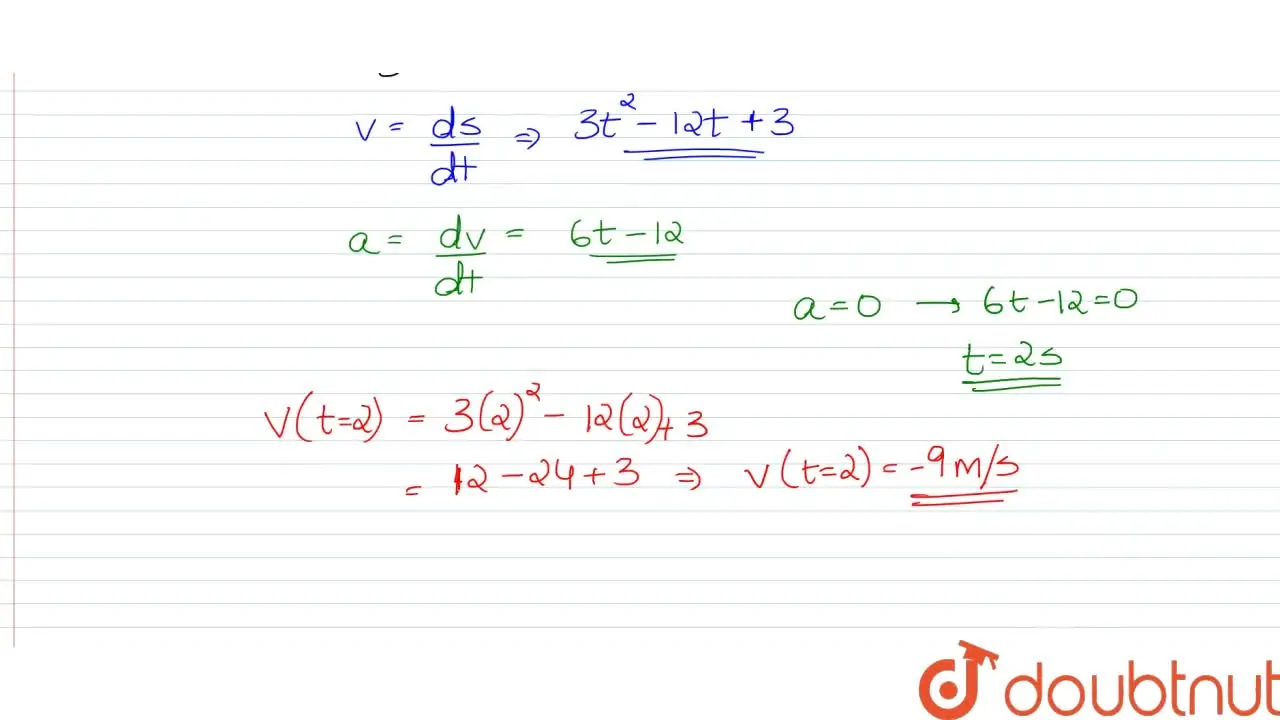(a) If the initial velocity of a particle is u and collinear acceleration at any time t is at, calculate the velocity of the particle after time t.
(b) A particle moves along a straight line such that its displacement at any time t is given by s=(t3−6t2+3t+4)m. What is the velocity of the particle when its acceleration is zero?
By definition acceleration =(dv/dt)
So, dvdt=at (given)
or ∫vudv=∫t0at
or v−u=12at2
or v=u+12at2
(b) As according to given problem,
s=t3−6t2+3t+4
instantaneous velocity
udsdt=3t2−12t+3
and acceleration
a=dvdt=d2sdt2=6t−12....(i)
So, acceleration will be zero when 6t−12=0, i.e., t=2 sec
And so the velocity when acceleration is zero, i.e., at t=2 sec from Eqn. (i), will be
v=3×22−12×2+3=−9m/s
[Negative velocity means that body is moving towards the origin, i.e., as time increases displacement decreases.]
Related Playlists
- BOOK - GRB PUBLICATIONCHAPTER - MOTION IN A STRAIGHT LINEEXERCISE - Problem14videos
MOTION IN A STRAIGHT LINE
- BOOK - GRB PUBLICATIONCHAPTER - MOTION IN A STRAIGHT LINEEXERCISE - Problems and Practice16videos
MOTION IN A STRAIGHT LINE
- BOOK - GRB PUBLICATIONCHAPTER - FRICTION AND CIRCULAR MOTION EXERCISE - Comprehension type11videos
FRICTION AND CIRCULAR MOTION
- BOOK - GRB PUBLICATIONCHAPTER - MOTION IN TWO AND THREE DIMENSIONSEXERCISE - All Questions210videos
MOTION IN TWO AND THREE DIMENSIONS
Similar Questions
If the initial velocity of aparticle is (u) collinera acceleration at any time (t) is at, calculate the velocity of the paraticle after time (t).
View SolutionA particle moves along a straight line such that its displacement s at any time t is given by s=t3−6t2+3t+4m, t being is seconds. Find the velocity of the particle when the acceleration is zero.
View SolutionA particle moves along a staight line such that its displacement at any time t is given by s=t3−6t2+3t+4m. Find the velocity when the acceleration is 0.
View SolutionA particle moves along a straight line such that its displacement at any time t is given by s=3t3+7t2+14t+5. The acceleration of the particle at t=1s is
View SolutionFor a particle moving in a straight line, the displacement of the particle at time t is given by
S=t3−6t2+3t+7
What is the velocity of the particle when its acceleration is zero?View SolutionA particle moves along x-axis and its displacement at any time is given by x(t)=2t3−3t2+4t in SI units. The velocity of the particle when its acceleration is zero is
View SolutionA partical is moving in a straight line such that its displacement at any time t is given by s=4t3+3t2. Find the velocity and acceleration in terms of t.
View SolutionThe initial velocity given to a particle is u and accelration is given by a=at32 . What will be the velocity of particle after time t.
View SolutionThe distances moved by a particle in time t seconds is given by s=t3−6t2−15t+12. The velocity of the particle when acceleration becomes zero, is
View SolutionA particle moves in a straight line such that the displacement x at any time t is given by x=6t2−t3−3t−4. X is in m and t is in second calculate the maximum velocity (in ms−1) of the particle.
View Solution


